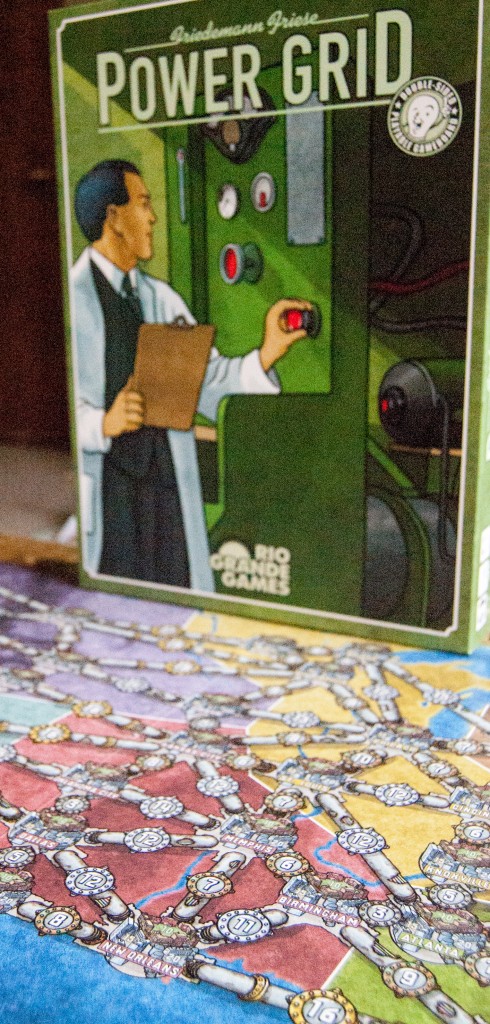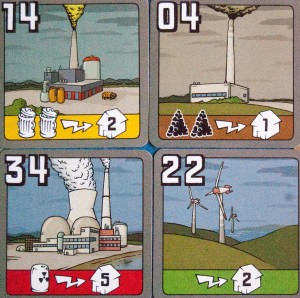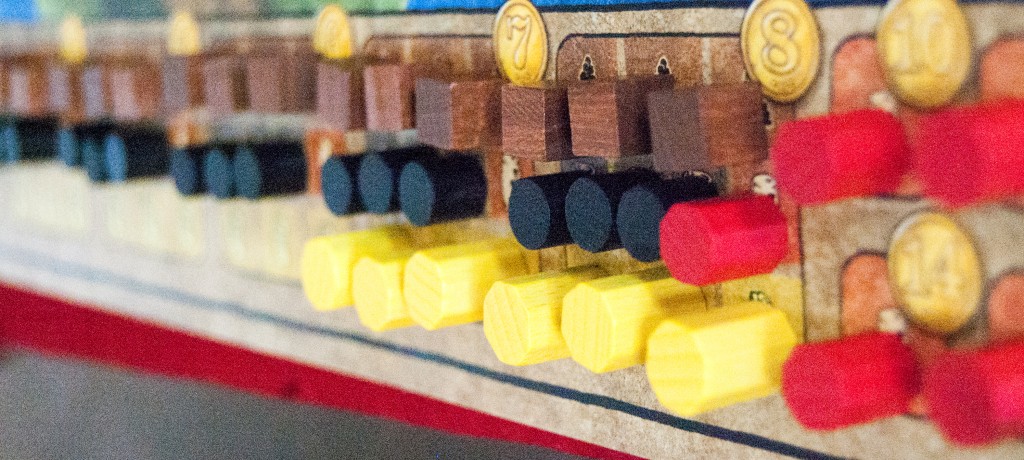Board game review: "Power Grid"
The most important thing to know about a new board game is what role chance has in the play. To pick extreme examples, children’s classic “Candy Land” is entirely luck — you can’t be good or bad at Candy Land, you just draw randomly shuffled cards and do what they say. Chess, on the other hand, is pure strategy and no luck — both sides are perfectly balanced and there are no random elements.
 Many of the best games have an element of both — a heavy role for strategy, so players’ abilities are tested, but some role for luck as an equalizer, to help keep less-experienced players in the game to the end. Games can be full with lots of one and a little bit of another, but generally speaking, I prefer an emphasis on strategy over luck — controlling your own destiny is more interesting to me than depending on the whims of a dice roll.
Many of the best games have an element of both — a heavy role for strategy, so players’ abilities are tested, but some role for luck as an equalizer, to help keep less-experienced players in the game to the end. Games can be full with lots of one and a little bit of another, but generally speaking, I prefer an emphasis on strategy over luck — controlling your own destiny is more interesting to me than depending on the whims of a dice roll.
All that is prelude to saying that German import “Power Grid” (translated from the original, fantastic German name “Funkenschlag”) is my very favorite board game right now. It’s not purely strategy — there’s a deck of partially shuffled cards, for example — but generally speaking what happens in the game is almost entirely the result of player’s choices. But the brilliance of Power Grid is that it didn’t get rid of chance at the expense of game balance. To the contrary, several elegant (if intricate) mechanisms subtly penalize players in the lead and boost those trailing. The result is a gripping game where every action (or deliberate inaction!) has consequences, where a low key initial game builds to a high-pressure finish. If you like games that force you to think, strategize, and weigh difficult choices, you’ll love Power Grid.
Below: Four of Power Grid’s power plants, showing their base cost, how much fuel each takes and how many cities they can power.

Power Grid puts the players in the role of competing power magnates, trying to expand their company to dominate the electrical industry of the United States, or Germany (or other countries and regions sold separately). The core of the game involves three different steps repeated each turn:
First, players buy power plants, bidding against each other in an auction. At the start of the game, power plants are relatively inefficient — requiring a lot of fuel to power just a city or two. Consequently, they’re cheaper, costing just a few bucks of the game’s currency to buy — unless other players fix their eyes on the same plant and raise your bids. These bidding wars can drive the cost way up from its opening offer, and sometimes that’s even worth it. There’s a few different kinds of power plants, each of which takes a different kind of fuel — coal, oil, garbage or uranium, plus some “green” plants with no required inputs.
This matters because of the second step: players buy fuel from the market to power their plants. This is done in turn order, not via auction — but like the auctions, the law of supply and demand is on full display. There’s a limited supply of each resource, and the more players buy a resource, the higher the price gets. Don’t let the talk of economics scare you — this is clearly indicated on the board, not something involving finicky math. So even though coal starts out as cheap and abundant, and uranium is several times more expensive, if all your rivals have coal plants they could soon find it scarce and pricey, while you have cheap uranium all to yourself.
 Power Grid’s resource track, showing the coal (brown), oil (black), garbage (yellow) and uranium (red) available for purchase and how much each costs. The more of a resource gets purchased, the more each unit is worth.
Power Grid’s resource track, showing the coal (brown), oil (black), garbage (yellow) and uranium (red) available for purchase and how much each costs. The more of a resource gets purchased, the more each unit is worth.
Finally, players build infrastructure to cities — so they can sell the electricity they generate to customers and earn money. This costs money for each city — plus extra money for overland connections between two cities. The cities of New England are cheap to reach, while the vast expanses west of the Mississippi will require a lot to spend. On the other hand, you might not have as much competition there because of the price, letting you keep expanding as others find their reach stymied.
After all that, players burn off their resources to power as many cities as they can. The more cities you power, the more money you get — but the more money it cost you to get there. And you can never, ever, rest on your laurels — every other turn at the minimum, if not every turn, you’ll be emptying your wallet on plants, resources and cities. Sometimes doing little or nothing for a turn can be the right move, to avoid overpaying for something, or to husband your money for the next turn when a much better power plant will become available. But the competition is fierce and laggards will pay the price.
Another plus is that the game doesn’t involve direct conflict between players. There’s no combat or attacks, no destroying other players’ hard work. But unlike some hobby games which can seem more like everyone playing their own solo game at the table, it does involve player interaction — and indeed makes it integral to the game.
 The way the game incorporates competition and supply and demand is its most elegant aspect. But key to the game’s success is the system it puts in place to ensure balance. This is primarily done through artificially manipulating turn order, so players who are doing better are the last ones to buy resources and build into cities — meaning they’ll pay more and find their routes blocked. Leaders also are the first ones to bid on power plants, which hurts them because later in the auctions better power plants tend to become available. (Veteran players talk about the concept of “leading from behind” — intentionally keeping your income low to benefit from this system even as you position yourself for a late surge to the front. Of course, the fact that veterans can game this mechanic like this is partially a downside, in that it doesn’t help new players as much as you might think.)
The way the game incorporates competition and supply and demand is its most elegant aspect. But key to the game’s success is the system it puts in place to ensure balance. This is primarily done through artificially manipulating turn order, so players who are doing better are the last ones to buy resources and build into cities — meaning they’ll pay more and find their routes blocked. Leaders also are the first ones to bid on power plants, which hurts them because later in the auctions better power plants tend to become available. (Veteran players talk about the concept of “leading from behind” — intentionally keeping your income low to benefit from this system even as you position yourself for a late surge to the front. Of course, the fact that veterans can game this mechanic like this is partially a downside, in that it doesn’t help new players as much as you might think.)
These mechanics, combined with a few others, are one of the primary downsides of the game: it’s got a lot of little complicated elements that can be too much for some people — especially if no one at the table has played before to help teach and run things. Calculating the changes in turn order, figuring out how many resources to add each turn and handling all intricacies of the auctions can all seem overwhelming. Plus, many of these rules are artificial, without any benefit in theme, and don’t flow intuitively from the rules.
Even setting all that aside, the end game can involve quite a bit of math as players try to stretch their bank accounts for the final push. For me, this is a thrill (though I like to play with a pen and paper so I can jot down the various possibilities as I wait for my turn), but I can see how it would be a chore for people who like more casual games.
Power Grid isn’t for everyone. It’s involved, stressful and moderately complicated. People who like more casual games, or games with more of a random element, probably wouldn’t have fun with Power Grid. But for people who thrive on competition and strategy, it’s nigh perfect.
The game can incorporate anywhere from two to six players, though I’m told it’s best with four to six. (I’ve only ever played it with the larger groups.) Games take about 90 minutes to two hours. It involves both small pieces and math, so probably isn’t suitable for all but the most precocious children.
You can buy Power Grid at a local hobby store or on Amazon. Alternately, I own it and will gladly play it with you. Apologies in advance for beating you.